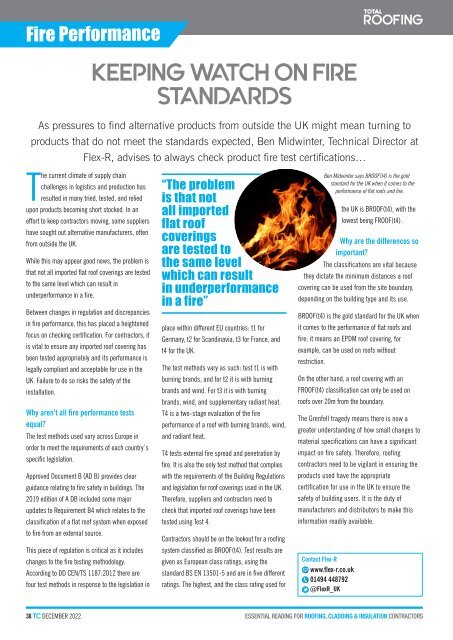December 2022
Create successful ePaper yourself
Turn your PDF publications into a flip-book with our unique Google optimized e-Paper software.
Fire Performance<br />
KEEPING WATCH ON FIRE<br />
STANDARDS<br />
As pressures to find alternative products from outside the UK might mean turning to<br />
products that do not meet the standards expected, Ben Midwinter, Technical Director at<br />
Flex-R, advises to always check product fire test certifications…<br />
The current climate of supply chain<br />
challenges in logistics and production has<br />
resulted in many tried, tested, and relied<br />
upon products becoming short stocked. In an<br />
effort to keep contractors moving, some suppliers<br />
have sought out alternative manufacturers, often<br />
from outside the UK.<br />
While this may appear good news, the problem is<br />
that not all imported flat roof coverings are tested<br />
to the same level which can result in<br />
underperformance in a fire.<br />
Between changes in regulation and discrepancies<br />
in fire performance, this has placed a heightened<br />
focus on checking certification. For contractors, it<br />
is vital to ensure any imported roof covering has<br />
been tested appropriately and its performance is<br />
legally compliant and acceptable for use in the<br />
UK. Failure to do so risks the safety of the<br />
installation.<br />
Why aren’t all fire performance tests<br />
equal?<br />
The test methods used vary across Europe in<br />
order to meet the requirements of each country’s<br />
specific legislation.<br />
Approved Document B (AD B) provides clear<br />
guidance relating to fire safety in buildings. The<br />
2019 edition of A DB included some major<br />
updates to Requirement B4 which relates to the<br />
classification of a flat roof system when exposed<br />
to fire from an external source.<br />
This piece of regulation is critical as it includes<br />
changes to the fire testing methodology.<br />
According to DD CEN/TS 1187:2012 there are<br />
four test methods in response to the legislation in<br />
“The problem<br />
is that not<br />
all imported<br />
flat roof<br />
coverings<br />
are tested to<br />
the same level<br />
which can result<br />
in underperformance<br />
in a fire”<br />
place within different EU countries: t1 for<br />
Germany, t2 for Scandinavia, t3 for France, and<br />
t4 for the UK.<br />
The test methods vary as such: test t1 is with<br />
burning brands, and for t2 it is with burning<br />
brands and wind. For t3 it is with burning<br />
brands, wind, and supplementary radiant heat.<br />
T4 is a two-stage evaluation of the fire<br />
performance of a roof with burning brands, wind,<br />
and radiant heat.<br />
T4 tests external fire spread and penetration by<br />
fire. It is also the only test method that complies<br />
with the requirements of the Building Regulations<br />
and legislation for roof coverings used in the UK.<br />
Therefore, suppliers and contractors need to<br />
check that imported roof coverings have been<br />
tested using Test 4.<br />
Contractors should be on the lookout for a roofing<br />
system classified as BROOF(t4). Test results are<br />
given as European class ratings, using the<br />
standard BS EN 13501-5 and are in five different<br />
ratings. The highest, and the class rating used for<br />
Ben Midwinter says BROOF(t4) is the gold<br />
standard for the UK when it comes to the<br />
performance of flat roofs and fire.<br />
the UK is BROOF(t4), with the<br />
lowest being FROOF(t4).<br />
Why are the differences so<br />
important?<br />
The classifications are vital because<br />
they dictate the minimum distances a roof<br />
covering can be used from the site boundary,<br />
depending on the building type and its use.<br />
BROOF(t4) is the gold standard for the UK when<br />
it comes to the performance of flat roofs and<br />
fire; it means an EPDM roof covering, for<br />
example, can be used on roofs without<br />
restriction.<br />
On the other hand, a roof covering with an<br />
FROOF(t4) classification can only be used on<br />
roofs over 20m from the boundary.<br />
The Grenfell tragedy means there is now a<br />
greater understanding of how small changes to<br />
material specifications can have a significant<br />
impact on fire safety. Therefore, roofing<br />
contractors need to be vigilant in ensuring the<br />
products used have the appropriate<br />
certification for use in the UK to ensure the<br />
safety of building users. It is the duty of<br />
manufacturers and distributors to make this<br />
information readily available.<br />
Contact Flex-R<br />
www.flex-r.co.uk<br />
01494 448792<br />
@FlexR_UK<br />
38 TC DECEMBER <strong>2022</strong>

















